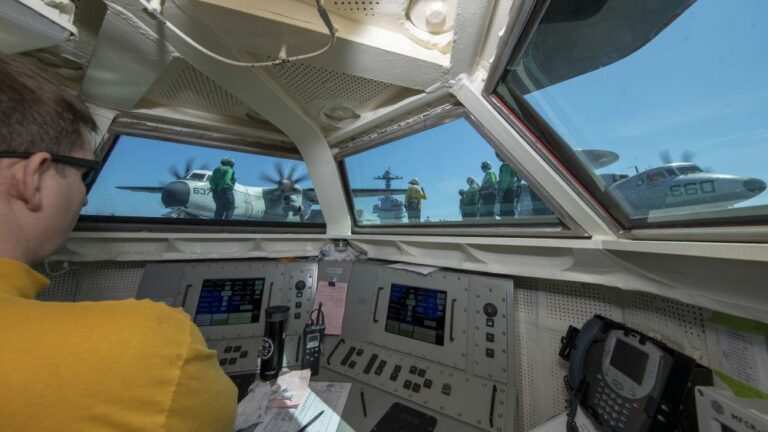
From up in the flight deck “bubble” at the bow of USS Gerald R. Ford, the new catapult that launches planes looks a lot better than it does to critics of the delays and cost overruns of the system.
The Ford’s Electromagnetic Aircraft Launch System (EMALS) doesn’t need as many sailors to operate and maintain it as do steam-powered catapults on the Nimitz class carriers that have served as the Navy’s main battle wagons since the 1970s.
And, says Petty Officer 1st Class Fiona McMahon, whose job is to work side by side with the Ford’s shooter — the officer who launches planes — in that bubble, when her computer monitor signals a glitch, it’s a lot easier to deal with.
“Basically, down below, they can press a button … it’s like a reset and we’re ready to go,” she said.
It wasn’t that easy, or that fast, when the pressure gauges she watched working on the flight deck of USS Abraham Lincoln dipped below the 475 psi mark, or the ones on USS Dwight D. Eisenhower slipped below 520.
Then, it meant a call to the steam engineering department. That often meant another call to the reactor department, to get the steam pressure back up.
“I think we’re launching planes even faster than Nimitz carriers can,” McMahon said.
And even though the teams staffing the EMALSs are smaller, there’s one big difference that McMahon enjoys.
On Nimitz carriers, after a long day of operations, she had her fellow aviation boatswains mates often had to work well into the night on maintenance.
The Ford’s new ways of speeding planes into the air and then catching them safely when they land draw plenty of critical attention in Washington.
A series of Government Accountability Office studies since 2007 criticized the Navy’s approach in contracting for those systems, arguing that it had promised cost and delivery deadlines that were unrealistic given the incompletely-developed state of the technology.
By 2017, when the Navy took delivery of the Ford, the cost of building and installing General Atomics’ EMALS had climbed 352% from the Navy’s original forecast to reach nearly $670 million, the GAO reported that year.
The cost of the arresting gear system, another General Atomics project, nearly doubled, to $148 million.
The new systems also mean there’s lots to learn for the second generation of Ford sailors who are operating and maintaining those systems.
Most of the Ford’s original crew have rotated off the ship. They’re the team that tested and first developed procedures for the EMALS and the Ford’s new advanced arresting gear system. There are still plenty of challenges as their replacements further refine procedures for running the systems, said Cmdr. Rodney King, the Ford’s aircraft handling officer, who controls the movement of all aircraft onboard and coordinates all maintenance work.
“I don’t think there’s been a crew that faced the same challenges in 40 years,” King said.
That is, the last time the cohort of sailors who followed USS Nimitz’s plank-owners had to figure out how to operate all the new technology on that carrier, the lead ship for its class of 10 nuclear carriers
The motors, magnets and controls of the Ford’s catapults and arresting gears are radically different from the Nimitz class carriers’ systems, which are based on steam and hydraulics — powerful flows of fluid to move planes fast and absorb the shock of sudden stops from high speed.
“I feel like I’m learning something every day,”said Petty Officer 1st Class Kimberley O’Donnell, who leads a team of aviation boatswains mates responsible for the arresting gear.
Instead of the hands-on inspection of parts and piping she’s used to from a decade on Nimitz-class carriers, she has to diagnose problems by monitoring computer screens and data about the gear’s electrical circuits.
In years past, when she could tap both a formal and informal and fleet-wide base of knowledge about flight deck systems, she and her team are still exploring.
“We all learn basic electricity, but there’s a lot more in these circuits,” she said.
O’Donnell went to school for a month to learn about the circuits and controls of the Ford’s arresting gear.
Still, there’s nothing like getting a hands-on feel, getting to know the system and sometimes dealing with faults and failing parts, she said.
“But you know, on any ship,” she said, “There’s always things to fix.”
___
(c) 2021 the Daily Press
Distributed by Tribune Content Agency, LLC.
0 comments :
Post a Comment